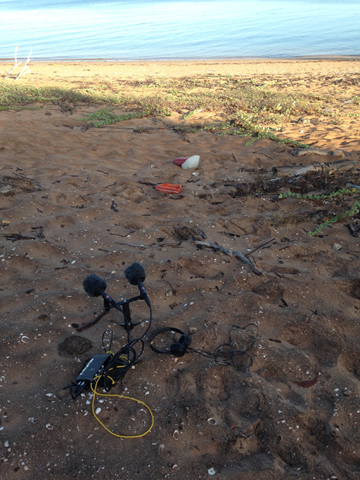Concert, radio composition and publication form three parts of this music- and soundrelated work:
Cobourg Nets
Project development in 2019/20: research Kirsten Reese supported by music residence grant of Goethe-Institut 2019, work grant from the Berlin Senate Department for Culture and Europe in 2019 Located on the central northern tip of Australia, the Cobourg Peninsula was named by Europeans in 1818 after Prince Leopold of Saxe-Coburg. From 28 July to 4 August 2019, I embarked on a field trip to the peninsula, to visit the British settlement of Victoria at Port Essington (1838–1849) in today's Garig Gunak Barlu National Park. Victoria had been the destination of the Brandenburg naturalist Ludwig Leichhardt, the first European “explorer” to map a route of over 4,000 kilometres from present-day Brisbane to Port Essington in 1845. Port Essington represents a British attempt at colonisation “from the sea” under military command, with the aim of establishing a new port (like Singapore) and thus establishing dominance in northern Australia. The settlement failed partly due to a lack of adaptation to environmental conditions, while also precipitating a dramatic decline in the indigenous population in the following decades. More recently, Leichhardt’s records (Journal of an Overland Expedition to Port Essington) have been used in land claim proceedings to prove that the territory in question had been occupied before the Europeans arrived. An iridescent grasshopper, "Leichhardt's grasshopper", called Alyurr in one of the indigenous languages refers to the lightning spirit Namarrkon, who appears in the at least 27,000-year-old cave paintings on the Arnhem Plateau. On the field trip I slept outdoors, visited famous rock paintings in Kakadu National Park, examined objects I found on the coastal beaches and in the ruins of Victoria, collected sounds and photos, and researched the history and ecology of Cobourg. I spoke to rangers, experts on indigenous knowledge for example about plants and food, entomologists and other scientists and artists. I visited natural history museums in Australia’s larger cities and continued my investigations in Berlin, where objects from Leichhardt’s travels have ended up in botanical and other collections. Following on from Leichhardt’s grasshopper, I researched insect sounds in bioacoustic archives around the world – insects that produce fascinatingly diverse and electronic-sounding noises, as a contemporary metaphor of the distant, the unknown and the other", and also of the small and the marginalised. This material forms the starting point for the musical and artistic exploration of different forms and systems of knowledge: scientific knowledge, indigenous knowledge (a text on Yolgnu/Aboriginal thinking by the linguist Michael Christie, who teaches in Darwin, refers to “grounded and ex-centric knowledge”), artistic knowledge, “situated knowledge”, i.e. knowledge through presence in a place, knowledge through experience, collective and personal knowledge and, above all, knowledge conveyed through sound (“sonic knowledge”). The whole project occupied me for two and a half years, during which I, too, amassed a great deal of knowledge based on experiences during the journey, from reading books and texts before and after the trip, as well as insights and reflections that arose through consultation with colleagues, musicians and academics from Australia and in postcolonial and ecological discussion contexts here in Germany. This knowledge now forms the space surrounding the musical composition and belongs to the overall project. The project exists in four different formats: • The ensemble composition Cobourg Nets for percussion, harp, flute and clarinet with field recordings in which researched insect sounds and instrumental sounds refer to each other as a result of translation processes • The publication Mind Maps Folder in which, starting with my own mind maps, I bring together contextual knowledge on five topics: • A collection of books and exhibits brought back from Australia • The radio composition Field Log Cobourg, commissioned by Deutschlandfunk Kultur, an acoustic logbook that, with the aid of field recordings and a descriptive and narrative text, seeks to communicate the auditory experience and the dialogue with people locally and addresses the subjective experience of hearing and sound as a repository of knowledge. Included are conversations with Robert Risk (Indigenous ranger), Keith Risk (Indigenous Elder) and Robert Raven (arachnologist at the Queensland Museum) to whom I wish to express my thanks. The trip to Australia with all its different aspects of experience was a form of artistic research for me, crystallising during the eight days of the field trip from Darwin to Cobourg as an existential exploration of my own hearing and listening. A fundamental experience was that of listening while lying on the ground, protected only by a mosquito net. Although I didn’t understand what the insects were saying, I did hear and understand that they were communicating. Cobourg is a project that relates questions of contemporary postcolonial discourse to a concrete situation, a historical context, a site-specific experience. Who is speaking, and who is allowed to speak for whom? Cobourg is a work from a European and deliberately subjective point of view. The issues at stake are located in the larger context of a different approach to eco-systems and a reorientation of Western economics, the necessity of which is clearly demonstrated by climate change rooted in European ways of thinking and of exercising power. The bushfires in Australia at the turn of 2019/20, i.e. at the end of the year of the Cobourg trip, laid bare the global interconnectedness of these issues.
for Ensemble und Field Recordings. 2021
Based on research at Cobourg Peninsula, Northern Territory, Australia 2019
premiere 6.5.2021, Festival "Memories in Music" Akademie der Künste Berlin
Ensemble Adapter (Kristjana Helgadóttir, Flöte; Ingólfur Vilhjálmsson, clarinet; Gunnhildur Einarsdóttir, harp; Matthias Engler, percussion)
Video > Stream 6.5.2021, Akademie der Künste Berlin
Festival Memories in Music
> programme book
Field Log Cobourg
radio compostion > Deutschlandfunk Kultur, first broadcast 7.5.2021
Cobourg Mind Maps
artist publication > digital version. printed version available on request

2. the naturalist Ludwig Leichhardt
3. Kakadu and Arnhem Land, the indigenous and ecological past and present
4. insects and biology, scientific knowledge
5. museums and collections, the postcolonial treatment of knowledge